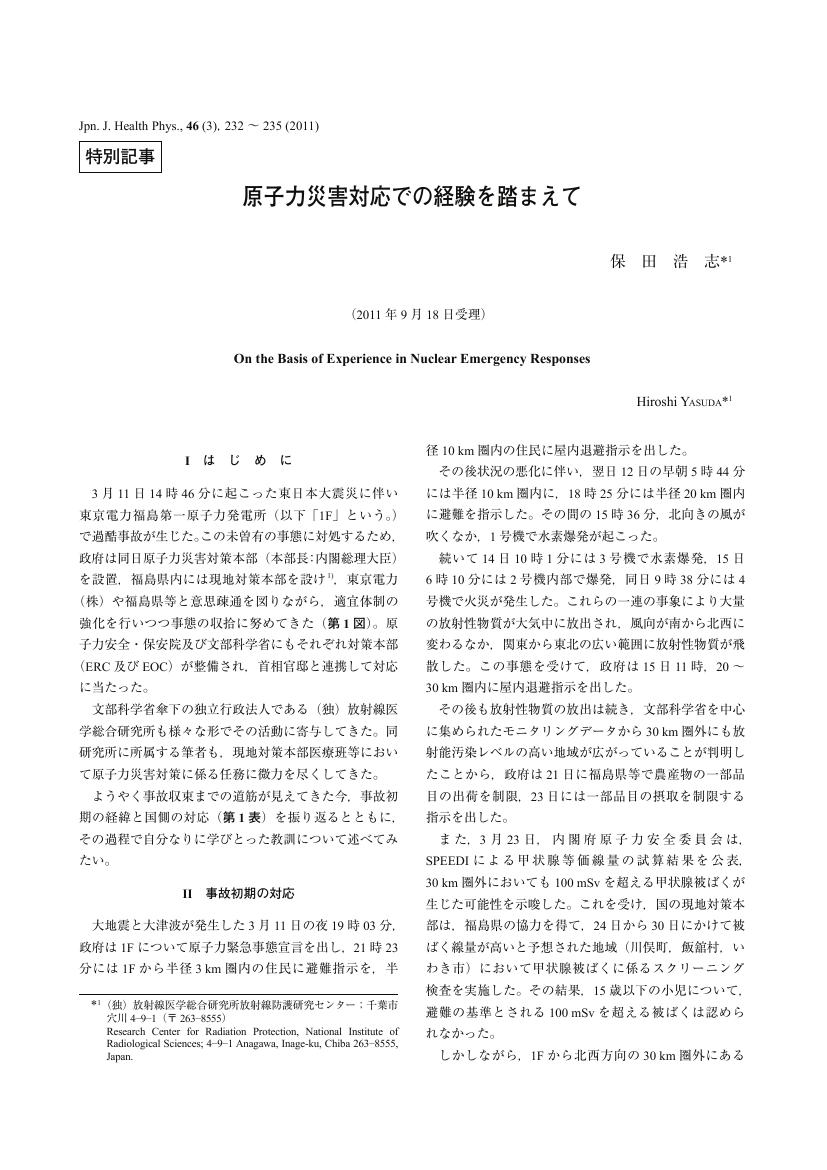1 0 0 0 OA 放射線防護に関する主な国際組織の活動と相互の関係
- 著者
- 保田 浩志 賞雅 朝子 飯本 武志
- 出版者
- 一般社団法人日本保健物理学会
- 雑誌
- 保健物理 (ISSN:03676110)
- 巻号頁・発行日
- vol.57, no.1, pp.30-35, 2022-03-31 (Released:2022-05-26)
- 参考文献数
- 3
In addition to the International Commission on Radiological Protection (ICRP), there are several international organizations that are engaged in activities related to radiological protection. This article briefly reviews the aims and major activities of and interrelationships between those organizations, followed by opinions about how Japanese experts should contribute to those activities.
1 0 0 0 OA 航空機搭乗時の宇宙線被ばくについて
- 著者
- 保田 浩志
- 出版者
- 日本放射線安全管理学会
- 雑誌
- 日本放射線安全管理学会誌 (ISSN:13471503)
- 巻号頁・発行日
- vol.5, no.1, pp.4-6, 2006 (Released:2011-03-17)
- 参考文献数
- 9
1 0 0 0 OA 宇宙環境を利用した宇宙放射線研究の将来シナリオ
- 著者
- 高橋 昭久 日出間 純 保田 浩志
- 出版者
- 日本マイクログラビティ応用学会
- 雑誌
- International Journal of Microgravity Science and Application (ISSN:21889783)
- 巻号頁・発行日
- vol.34, no.2, pp.340203, 2017 (Released:2019-12-25)
- 参考文献数
- 41
Space radiation is one of the major hazards for human health in space. Space radiation consists of various kinds of radiation including high energy heavy (HZE) ions; these complex radiation fields cannot be produced on the ground. In the International Space Station (ISS), exposure doses are approximately 200 times higher than on the Earth’s surface. On the Moon and Mars, the radiation level is high, due to HZE ions. While the ISS is in free fall, the Moon has 1/6, Mars 1/3 of Earth's gravity. Many aspects of the biological effect of the combination of the lower gravity environment and space radiation remain unclear. But the future mission is now being planned to go to the Moon and Mars. It is necessary to clarify the problem of biological effect and physical dosimetry and then to resolve them as soon as possible. With this thought, here we try to present a scenario of space radiation research for next decades.
1 0 0 0 OA 原子力災害対応での経験を踏まえて
1 0 0 0 OA 太陽高エネルギー粒子被ばく予測モデルの研究開発
太陽の爆発現象から地球に向かって放出される太陽高エネルギー粒子(SEP)の影響は、最大規模のもので航空機パイロットの1年間の被ばく線量基準に達するおそれがあるため、宇宙天気予報でも最重要課題として知られている。最高エネルギーSEPによる航空機被ばく線量を物理的に、かつ定量的に予測することを目的とし、3段階モデルを用いて、過去に発生した最高エネルギーSEPイベントについて、地上の中性子モニター観測値を用いた定量的な検証を重ねることで、最高エネルギーSEPの宇宙天気予報システムWASAVIES (WArning System for AVIation Exposure to SEP) を開発した。

